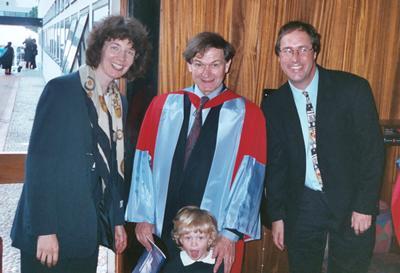Nobel Prize winner Sir Roger Penrose congratulated by Southampton academics

Academic colleagues from Mathematical Sciences and Physics and Astronomy at the University of Southampton have congratulated Professor Sir Roger Penrose after it was recently announced that he was awarded a share of this year’s Nobel Prize for Physics.
The prize was awarded to Sir Roger, recipient of an Honorary Doctorate from Southampton in 2002, alongside Professor Reinhard Genzel and Professor Andrea Ghez for their work on Black Holes. Sir Roger showed that “the discovery that Black Hole formation is a robust prediction of the general theory of relativity” while Professors Genzel and Ghez received the award “for the discovery of a supermassive compact object at the centre of our galaxy”.
Over many years, Sir Roger and his colleagues from the University of Oxford - where he is an Emeritus Professor of Mathematics – have visited Southampton to deliver seminars and public talks on relativity and his work.
"This Nobel Prize recognises Sir Roger's seminal work on the formation of black holes and spacetime singularities, part of which was carried out in collaboration with my PhD supervisor, Stephen Hawking,” said Professor Marika Taylor, Head of Applied Mathematics at Southampton. “Fifty years on from Sir Roger's work, the theoretical and observational study of black holes sits at the forefront of fundamental science research. I have worked with Sir Roger on public events explaining cosmology and black holes at the Royal Institution and he is a captivating and inspirational scientist."
Ivette Fuentes Guridi, Professor of Physics at Southampton said: “I’m delighted for this tremendous and well-deserved global recognition of Roger’s contributions to Physics. Sir Roger has been an invaluable mentor to me and so many others around the world, helping to nurture and encourage our careers. I’ve had the privilege to collaborate with him, including two recent papers proposing experiments to test his ideas on the collapse of quantum superpositions due to gravity. And as a Founder in the Roger Penrose Institute, we will soon be working with Roger to bring the UK arm of the Institute to Southampton which is incredibly exciting.”

Sir Roger is particularly renowned for developing the ‘twistor theory’, a novel way to look at the structure of space-time which has led to a deeper understanding of the nature of gravity.
Although Black Hole solutions of Einstein’s equations were known to exist prior to the work of Penrose, the prevailing view was that gravitational singularities were the result of the high degree of symmetry in the particular examples that had been constructed.
This position changed considerably with the work of Penrose who showed in his 1965 paper that deviations from spherical symmetry could not prevent gravitational collapse. This was a ground-breaking paper in which topological methods new to general relativity were used together with ideas from differential geometry to show that the prediction of the existence of Black Holes was a stable prediction of general relativity. The 1965 paper had an immediate impact and inspired others such as Stephen Hawking to develop the modern approach to gravitational singularities.
Research in this field has been a key part of study by Southampton’s School of Mathematical Sciences with strong research links in other areas of mathematical relativity where Sir Roger has been active, such as his asymptotic structure of spacetime and the definition of gravitational energy.
Sir Roger is particularly renowned for developing the ‘twistor theory’, a novel way to look at the structure of space-time which has led to a deeper understanding of the nature of gravity. In fact, the last section of Sir Roger’s two-volume book “Spinors and space-time” is focused on the “Ludvigsen-Vickers proof” of the positivity of the Bondi mass-energy of spacetime, developed by Malcolm Ludvigsen, formerly of the University of York, and Southampton Professor James Vickers.
Professor Vickers also published a paper almost exactly 50 years after the original 1965 paper proving a version of the Penrose singularity theorem for low regularity metrics which strengthens the conclusion of the theorem.
“As an undergraduate I was lucky enough to be taught General Relativity by Roger Penrose,” recalled Professor Vickers, who was instrumental in nominating Sir Roger for his Honorary Doctorate from the University of Southampton. “The excitement and insight provided by these lecture inspired me to want to do research in the area myself. Later when I was a postdoc researcher his work on local twistors played an important role in my work with Malcolm Ludvigsen on establishing the positivity of the Bondi mass which he encouraged me to develop further in order provide a definition of quasi-local mass in relativity.’’
See also here.